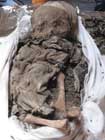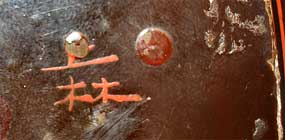|
| From the editor's desktop: Paths Less Trodden
|
| by Daniel Waugh |
2 |
| New research on nomads, mobility and routes, presented in recent publications, raises interesting questions about the future direction of ‘Silk Road studies.’ |
| |
 
|
Xiongnu Constituents of the High Mountains: Results of the
Mongol-American Khovd Archaeology Project, 2008,
|
| by Bryan Miller, Jamsranjav Bayarsaikhan, Prokopy B. Konovalov, Tseveendorj Egiimaa, Judy Logan, and Michelle Machicek |
8 |
| The excavations of the Mongol-American Khovd Archaeology Project in 2008 at the Shombuuziin-belchir cemetery revealed a range of interesting evidence about Xiongnu burial practices thanks to the excellent preservation of organic material and the fact that some graves at the site had not been looted. |
|
| |
| On the Chronology of the Noyon uul Barrows, |
| by Sergei S. Miniaev and Julia Elikhina |
21 |
| The authors review the evidence regarding the dating of the Xiongnu cemeteries at Noyon uul mountain in northern Mongolia, which is among the best known of Xiongnu sites. The evidence from inscriptions on lacquerware and silk, from a Chinese mirror fragment and from C-14 dating suggests that the cemeteries can be no earlier than the end of the1st century BCE and probably date to the 1st century CE. This dating is later than what many have assumed for the ‘Xiongnu cultural complex.’ |
| |
 
|
Chinese Lacquerware from Noyon uul: Some
Problems of Manufacturing and Distribution, |
| by Michèle Pirazzoli-t’Serstevens |
31 |
| Among the important datable objects in the Noyon uul graves is Chinese lacquerware, some with inscriptions. The article focuses on the inscriptions on two eared cups and the technique of a lacquered box to determine date, provenance and practices of distribution of these valuable objects. |
|
| |
| The Tomb of the Sogdian Master Shi: Insights
into the Life of a Sabao, |
| by Albert E. Dien |
42 |
| One of the most important recent discoveries concerning the activity of Sogdians in China is the 6th-century tomb of a Master Shi, located at Xi’an. The bi-lingual (Chinese and Sogdian) epitaph and the carved illustrations of scenes from his life provide important biographical data for this leader (sabao) of the Sogdian community. The article offers a new interpretation of this evidence. |
| |
| Buddhism in Mongolia Today: Introduction, |
| by Zsuzsa Majer and Krisztina Teleki |
51 |
| |
| Continuation or Disjuncture with the Past and
the Tibetan Buddhist Tradition, |
| by Zsuzsa Majer |
52 |
| Part of a larger project to document the recent history and present state of Mongolian Buddhism, this article reviews some of the challenges to the revival of the faith after the period of its destruction in the mid-20th century. Of particular significance is the question of monastic recruitment and education. |
| |
 
|
Building on Ruins, Memories and Persistence:
Revival and Survival of Buddhism in the
Mongolian Countryside, |
| by Krisztina Teleki |
64 |
| This report from the project on Mongolian Buddhism focuses on its survival in the countryside and the challenges of its restoration there, which are even greater than those experienced in the capital Ulaanbaatar. |
|
| |
| On the Road: Over the High Passes, |
| by Frank Harold, with photographs by Ruth Harold |
74 |
| In another of the author’s series describing and relating travel along the historic routes in Eurasia, the focus here is on the main passages through the Central Asian mountains: the Tien Shan, the Pamirs, the Karakoram and the Himalayas. |
| |
, Vol. 7 (Autumn 2009),


